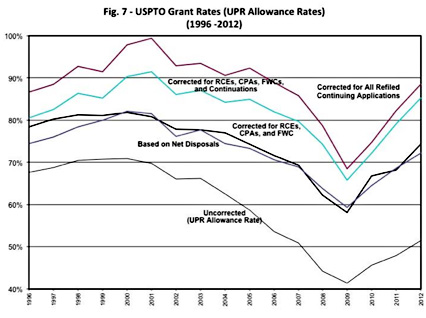Tim Lee has an interesting piece at Ars Technica today about a new (?) study that attempts to figure out how rigorous the patent office is at approving patents. Long story short, the authors take the uncorrected approval rate, and then adjust it for various factors to get a true idea of just how many  patent applications are approved. The headline result is that the patent office got steadily more selective during the Bush administration, and then suddenly reversed course in 2009 and started approving way more applications.
patent applications are approved. The headline result is that the patent office got steadily more selective during the Bush administration, and then suddenly reversed course in 2009 and started approving way more applications.
But something else caught my eye. The basic chart is on the right. The bottom line is the raw uncorrected approval rate. The lines above it each correct for a different factor until finally you reach the purple line at the top, which tells us the real rate of patent approvals. If this line is correct, the Patent Office approved about 99.5 percent of all patent applications in 2001.
So, um, what’s the deal with that? Can it really be true that virtually every single patent application that year eventually got approved?

















